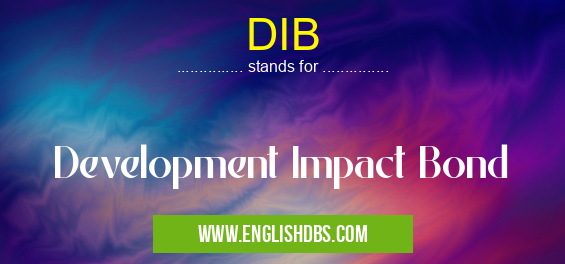What does DIB mean in DEVELOPMENT
A Development Impact Bond (DIB) is a relatively new form of impact investing that ties payments to the achievement of predetermined development outcomes. DIBs are an innovative, results-based funding mechanism that brings together traditional donors, private investors, and service providers to deliver development outcomes and ensure performance accountability. This type of investment helps to bridge the gap between philanthropy and impact investing as it gives investors the opportunity to achieve both financial returns and social returns on their investments. Ultimately, a DIB creates incentives for service providers to achieve pre-agreed upon outcomes and can help create sustainable development solutions at scale.

DIB meaning in Development in Community
DIB mostly used in an acronym Development in Category Community that means Development Impact Bond
Shorthand: DIB,
Full Form: Development Impact Bond
For more information of "Development Impact Bond", see the section below.
» Community » Development
Explanation
A DIB involves three parties: a donor agency or philanthropic organization that provides upfront capital, a service provider who delivers services with proven results such as health or education services, and an investor who funds the bond. The donor agency sets predetermined development goals which serve as milestones for measuring progress achieved by the service providers delivery of services. If those milestones are achieved then the investors receive a return on their original investment; if not, they receive none at all. In other words, through these incentives investors have a higher likelihood of receiving a positive return if they invest in delivering development outcomes rather than just contributing money without any guarantee of results.
Essential Questions and Answers on Development Impact Bond in "COMMUNITY»DEVELOPMENT"
What is a Development Impact Bond (DIB)?
A Development Impact Bond (DIB) is a pay-for-success contract that channels private capital from investors to fund socially beneficial outcomes. It serves as an innovative funding mechanism to finance programs focused on achieving social impact. Investors provide upfront capital, while other funders and donors pay for the successful achievement of pre-agreed targets. If results are achieved, investors receive their financial return plus an additional return based on performance.
Who can use DIBs?
DIBs are appropriate for any organization that wants to achieve social impact with the help of private capital, and can demonstrate the potential to meet specified targets and milestones. Non-profits, governments, foundations, educational institutions and others can all use DIBs for projects ranging from education reform to healthcare delivery systems.
What are the benefits of using DIBs?
There are numerous benefits associated with using DIBs over traditional financing methods, including providing access to new sources of capital, increasing efficiency and cost savings by only paying for success, engaging new stakeholders in financing and delivering targeted outcomes, and achieving greater accountability through rigorous evaluation.
How do DIBs spur innovation?
By incentivizing outcomes instead of activities or outputs, DIBs encourage organizations to develop creative solutions that produce lasting results more efficiently than traditional approaches. They also facilitate collaboration between multiple partners across sectors in order to achieve desired outcomes by utilizing different skillsets and resources more effectively.
How do I know if my organization is eligible for a DIB?
Generally speaking, if your organization has clear goals that can be measured with accurate data points, then it may be suitable for a development impact bond (DIB). Your organization should also have the capability to track progress towards those goals in order to receive finanical returns based on performance. Additionally, you must be able to demonstrate potential affinity among parties who will form the financial triangle required for setting up a Dib
How does one measure Social Impact?
The measurement of social impact depends largely on what goal your project seeks to achieve; however there are generally two different approaches which organizations take when measuring these impacts — qualitative measurements which emphasizes “subjective†elements such as self-reported satisfaction surveys; or quantitative measurements which focuses more on “objective†factors such as number of people impacted or number of services provided etc.
Final Words:
Overall, Development Impact Bonds are an innovative way to provide meaningful social change while also creating financial returns for investors. By creating incentives for service providers based on achieving predetermined developmental objectives rather than solely relying on donations or grants, DIBs can help generate sustainable results at scale and improve lives in communities across the world.
DIB also stands for: |
|
| All stands for DIB |
